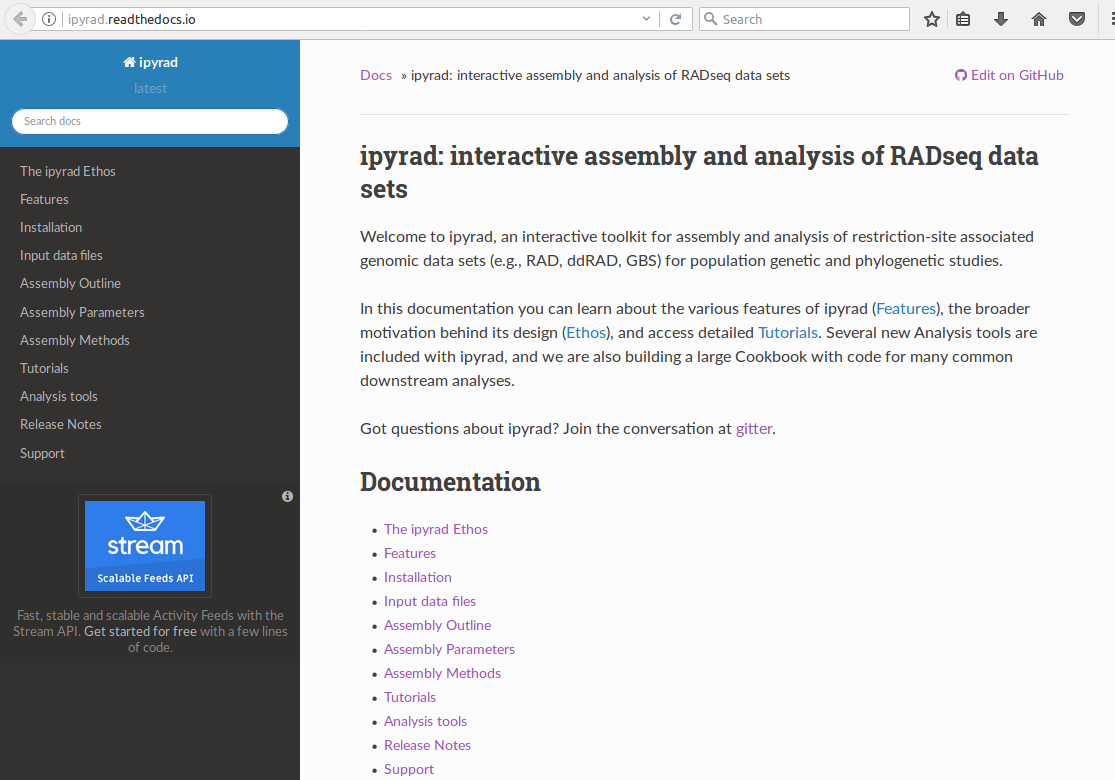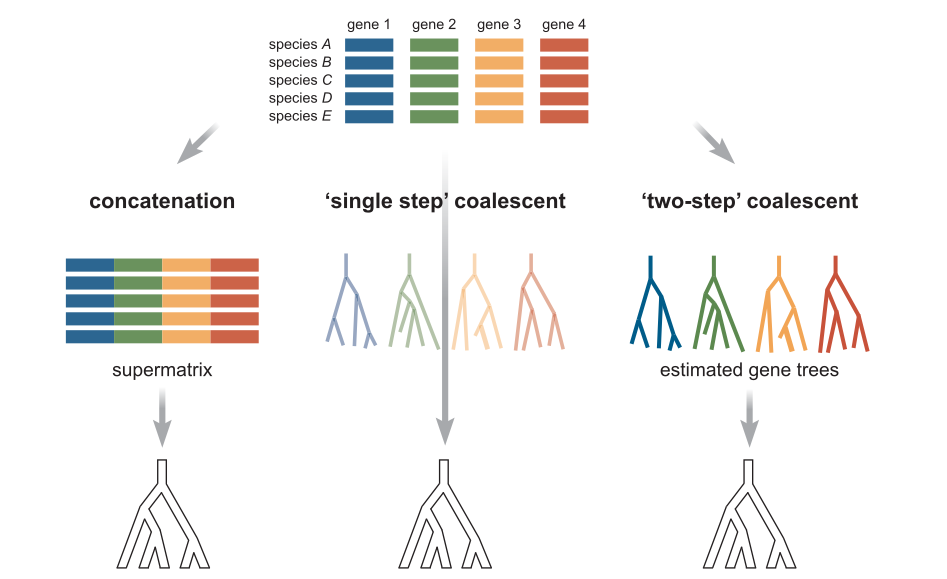Skills in this course:¶
- introduction to RAD-seq assembly
- ipyrad command line (CLI)
- ipyrad Python code (API)
- introduction to jupyter
- introduction to parallel computing in Python
Introduction to RAD-seq assembly¶
- Short reads (usually 50-150bp) single or paired.
- Loci usually align perfectly, not tiled into contigs.
- SNP data including full sequence data.
- usually ~1e3 - 1e6 loci.
- phased SNPs within loci, not phased between loci
- anonymous (denovo) or spatial-located (reference-mapped)
Available assembly software¶
- Standard reference-mapping approaches (BWA + Picard + GATK + ...)
- STACKS
- pyRAD)
- TASSEL-UNEAK
- ipyrad
Advantages to using ipyrad over the other methods:¶
- Provides denovo, reference, and denovo-reference hybrid assembly methods
- Includes alignment steps to allow for indel variation
- Fast and massively parallelizable (hundreds/thousands of cores)
- Low memory footprint, e.g., compared to stacks.
- Branching methods support reproducibility and exploring parameter settings
- Python API supports integration with Jupyter and scripting.
ipyrad online documentation¶

The ipyrad command-line (CLI)¶
And introduction to the ipyrad setup and parameter settings.
In [3]:
%%bash
ipyrad -n tutorial
New file 'params-tutorial.txt' created in /home/deren/websites/eaton-lab/slides/MBL
In [6]:
%%bash
cat params-tutorial.txt
------- ipyrad params file (v.0.7.5)--------------------------------------------
tutorial ## [0] [assembly_name]: Assembly name. Used to name output directories for assembly steps
./ ## [1] [project_dir]: Project dir (made in curdir if not present)
## [2] [raw_fastq_path]: Location of raw non-demultiplexed fastq files
## [3] [barcodes_path]: Location of barcodes file
## [4] [sorted_fastq_path]: Location of demultiplexed/sorted fastq files
denovo ## [5] [assembly_method]: Assembly method (denovo, reference, denovo+reference, denovo-reference)
## [6] [reference_sequence]: Location of reference sequence file
rad ## [7] [datatype]: Datatype (see docs): rad, gbs, ddrad, etc.
TGCAG, ## [8] [restriction_overhang]: Restriction overhang (cut1,) or (cut1, cut2)
5 ## [9] [max_low_qual_bases]: Max low quality base calls (Q<20) in a read
33 ## [10] [phred_Qscore_offset]: phred Q score offset (33 is default and very standard)
6 ## [11] [mindepth_statistical]: Min depth for statistical base calling
6 ## [12] [mindepth_majrule]: Min depth for majority-rule base calling
10000 ## [13] [maxdepth]: Max cluster depth within samples
0.85 ## [14] [clust_threshold]: Clustering threshold for de novo assembly
0 ## [15] [max_barcode_mismatch]: Max number of allowable mismatches in barcodes
0 ## [16] [filter_adapters]: Filter for adapters/primers (1 or 2=stricter)
35 ## [17] [filter_min_trim_len]: Min length of reads after adapter trim
2 ## [18] [max_alleles_consens]: Max alleles per site in consensus sequences
5, 5 ## [19] [max_Ns_consens]: Max N's (uncalled bases) in consensus (R1, R2)
8, 8 ## [20] [max_Hs_consens]: Max Hs (heterozygotes) in consensus (R1, R2)
4 ## [21] [min_samples_locus]: Min # samples per locus for output
20, 20 ## [22] [max_SNPs_locus]: Max # SNPs per locus (R1, R2)
8, 8 ## [23] [max_Indels_locus]: Max # of indels per locus (R1, R2)
0.5 ## [24] [max_shared_Hs_locus]: Max # heterozygous sites per locus (R1, R2)
0, 0, 0, 0 ## [25] [trim_reads]: Trim raw read edges (R1>, <R1, R2>, <R2) (see docs)
0, 0, 0, 0 ## [26] [trim_loci]: Trim locus edges (see docs) (R1>, <R1, R2>, <R2)
p, s, v ## [27] [output_formats]: Output formats (see docs)
## [28] [pop_assign_file]: Path to population assignment file
In [ ]:
In [ ]:
In [ ]:
In [ ]:
In [ ]:
